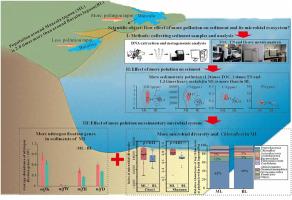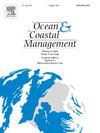Anthropogenic-derived nutrition increased microbial structure and nitrogen fixation: implication from different of Manzala and Burullus Lagoons in Nile Delta
IF 5.4
2区 环境科学与生态学
Q1 OCEANOGRAPHY
引用次数: 0
Abstract
Coastal lagoons and estuaries are critical ecotones that deliver valuable ecosystem services. However, they are being increasingly threatened by human activities. The response of sediment microbes to these pressures, specifically their structural composition and the carbon and nitrogen fixation functions they mediate, has not yet been well defined. This study assessed two Mediterranean coastal lagoons in Egypt (Manzala Lagoon, ML and Burullus Lagoons, BL), and examined the bioenvironmental properties, microbial community structures, and carbon and nitrogen fixation functions of sediments, using metagenome sequencing. The population surrounding ML was 2.0 times larger than that of BL, resulting in significantly elevated environmental pressures: the total nitrogen content in ML was twice that of BL, the total organic carbon (TOC) was 1.2 times higher, and the levels of pollutant heavy metal were 1.3 times greater. In response, Proteobacteria (65.5 %) and Chloroflexi (9.1 %) emerged as the dominant microbes and differed significantly between the two lagoons (p < 0.05). Furthermore, they mediated higher levels of carbon and nitrogen fixation genes in ML than in BL, and the nitrogen fixation genes in ML were 1.4 times higher than that in BL. Redundancy discriminant analysis revealed that elevated TOC promoted the proliferation of Chloroflexi in ML, which was further linked to an increase in nitrogen fixation gene abundance. These findings demonstrate the significance of wastewater treatment and nutrient input management for the health of the Nile Delta lagoon, and provide a genomic basis for nutrient input control in the management of coastal lagoon ecosystems worldwide.

人为来源的营养增加了尼罗河三角洲Manzala和Burullus泻湖的微生物结构和固氮作用
沿海泻湖和河口是提供有价值的生态系统服务的关键过渡带。然而,它们正日益受到人类活动的威胁。沉积物微生物对这些压力的反应,特别是它们的结构组成及其介导的碳和氮固定功能,尚未得到很好的定义。本研究评估了埃及两个地中海沿岸泻湖(Manzala Lagoon, ML和Burullus lagoons, BL),并利用宏基因组测序技术研究了沉积物的生物环境特性、微生物群落结构和碳氮固定功能。ML周围的种群数量是BL的2.0倍,环境压力显著升高:ML中总氮含量是BL的2倍,总有机碳(TOC)含量是BL的1.2倍,污染物重金属含量是BL的1.3倍。Proteobacteria(65.5%)和Chloroflexi(9.1%)成为优势菌群,在两个泻湖间差异显著(p < 0.05)。此外,它们介导的碳和氮固定基因在ML中的水平高于BL,其中ML中的固氮基因是BL的1.4倍。冗余判别分析表明,TOC的升高促进了Chloroflexi在ML中的增殖,这进一步与固氮基因丰度的增加有关。这些发现证明了废水处理和营养投入管理对尼罗河三角洲泻湖健康的重要性,并为全球沿海泻湖生态系统管理中的营养投入控制提供了基因组基础。
本文章由计算机程序翻译,如有差异,请以英文原文为准。
求助全文
约1分钟内获得全文
求助全文
来源期刊

Ocean & Coastal Management
环境科学-海洋学
CiteScore
8.50
自引率
15.20%
发文量
321
审稿时长
60 days
期刊介绍:
Ocean & Coastal Management is the leading international journal dedicated to the study of all aspects of ocean and coastal management from the global to local levels.
We publish rigorously peer-reviewed manuscripts from all disciplines, and inter-/trans-disciplinary and co-designed research, but all submissions must make clear the relevance to management and/or governance issues relevant to the sustainable development and conservation of oceans and coasts.
Comparative studies (from sub-national to trans-national cases, and other management / policy arenas) are encouraged, as are studies that critically assess current management practices and governance approaches. Submissions involving robust analysis, development of theory, and improvement of management practice are especially welcome.
 求助内容:
求助内容: 应助结果提醒方式:
应助结果提醒方式:


